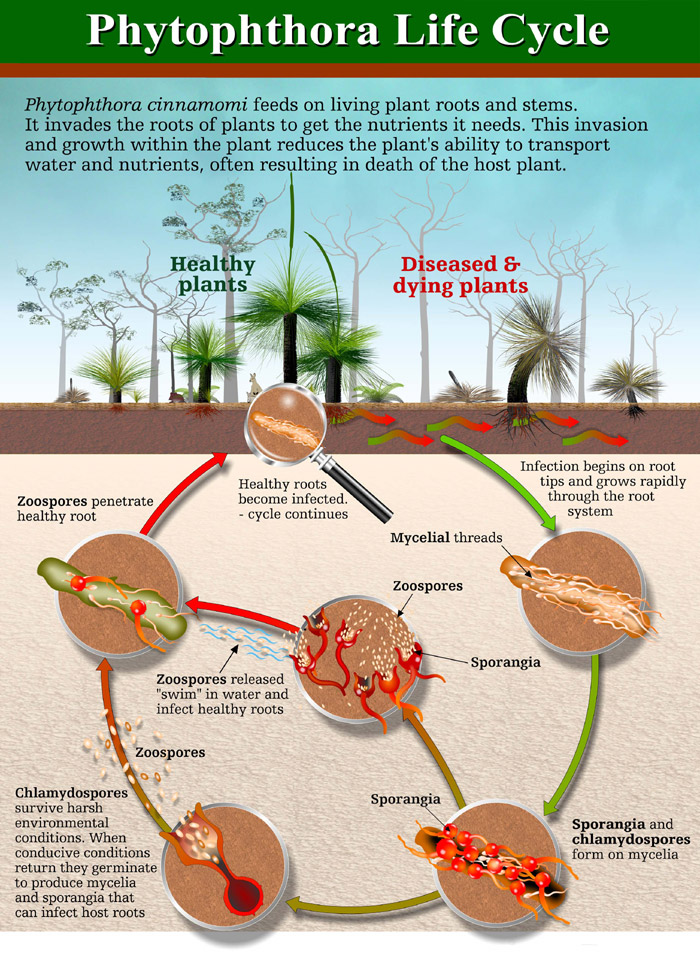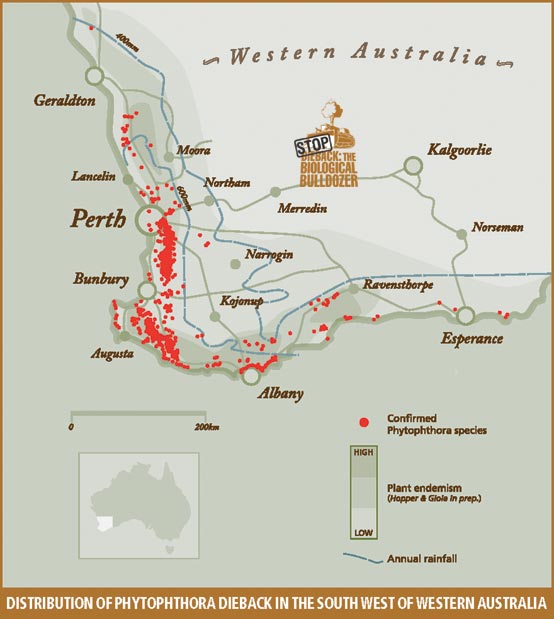Phytophthora Dieback is a highly destructive plant disease that can disrupt entire terrestrial ecosystems, impact biodiversity, affect cultural values and costs industries, government and landowners each year in their attempts to mitigate the impacts it causes.
In scientific terms, this plant disease is caused by a group of soil-borne water moulds in the genus Phytophthora. Pronounced ‘Fy-tof-thora’ – meaning plant destroyer in Greek, there are over 140 species of Phytophthora.
Note, the term ‘dieback’ can be used to describe tree decline caused by salinity, drought, insect damage, etc. To overcome any confusion, the term ‘Phytophthora Dieback’ should be used.
Phytophthora Dieback spends its entire life in the soil and in plant tissue. It causes root-rot in susceptible plants and trees which limits their uptake of water and nutrients – resulting often in rapid death or dying-back of the plant. Soil that is warm and moist provides the best conditions for Phytophthora allowing it to produce millions of spores. These spores are attracted to plant roots by swimming through the soil water.

Phytophthora Dieback is widespread globally where Mediterranean climates and vulnerable vegetation occurs. In the south west of Western Australia areas at risk where the disease has been found occur between Jurien and east of Esperance where annual rainfall is sufficient for the disease to survive. The Department of Biodiversity, Conservation and Attractions defines the vulnerable zone for Dieback as areas with over 400mm of annual rainfall. Some positive Dieback samples have been retrieved from areas within the 300-400mm rainfall zone, if they receive high summer rainfall (50-80mm between December and January).
View the vulnerable area at risk of Phytophthora Dieback in Western Australia’s South West.

Source: State PD Management & Investment Framework 2014
In sloping areas, Phytophthora Dieback spreads quickly in surface and sub-surface water flows. It spreads slower up-slope and on flat ground (approximately 1 m per year) because it is restricted to movement by root-to-root contact.
However, it is a human activity that causes the most significant, rapid and widespread distribution of this pathogen. Road construction, earth moving, driving infested vehicles on bush roads and stock movement can all contribute significantly to the spread of Phytophthora Dieback. Bush restoration projects may also inadvertently spread the pathogen.
Soil that is warm and moist provides the best conditions for Phytophthora Dieback. These conditions allow the pathogen to produce millions of spores. These spores are attracted to the plant roots by swimming through the soil water.
Over 40% of native WA plant species are susceptible to Phytophthora Dieback. Over 50% of the WA’s rare or endangered flora species are susceptible. Many of these plants are only found in the Southwest Australia Ecoregion. Some of the region’s more common plants are susceptible, including Jarrah, banksias, grass trees and zamia palms.
A more extensive list of susceptible plants can be downloaded from The Centre for Phytophthora Science Management website. A range of horticultural crops and garden plants are also susceptible to P. cinnamomi including apple, peach, apricot and avocado trees, grapevines, radiata pine, camellias, azaleas, roses, proteas and rhododendrons.
When Phytophthora Dieback spreads to bushland, it kills many susceptible plants, resulting in a permanent decline in the diversity of the bushland. It can also change the composition of the bushland by increasing the number of grasses and reducing the number of shrubs. Native animals that rely on susceptible plants for survival are reduced in numbers or are eliminated from sites infested by Phytophthora Dieback.
However, it is important to realise that bushland infested with Phytophthora Dieback still retains important conservation values. It contains remnant vegetation that provides habitat for many native animal species and provides environmental services, such as protecting the landscape from the effects of salinity and erosion. Therefore, it is important to retain and maintain remnant bushland even when it is affected by Phytophthora Dieback.
Dieback could be in your garden killing your roses, it could be in the bush around your holiday home near Dunsborough or a threat to your flower farm near Walpole. Phytophthora Dieback could also be at your favourite picnic spot near the Mundaring Weir or in the bushland near your favourite fishing spot near Bremer Bay.
To successfully reduce the spread and impact of Phytophthora Dieback we need the involvement of the community. Phytophthora Dieback should be an important issue for home gardeners, landscapers, new home builders, off road vehicle enthusiasts & bushwalkers. In particular the public need to:
- ask for dieback-free materials such as soil, gravel, potting mix, mulch and plants;
- don’t spread soil or mud around bushland; and
- observe signage in your local bushland reserve.
To successfully reduce the spread and impact of Phytophthora Dieback we need your help.
Phytophthora Dieback should be an important issue for home gardeners, landscapers, new home builders, off-road vehicle enthusiasts & bushwalkers. In particular the public need to:
- Ask for dieback-free materials such as soil, gravel, potting mix and mulch;
- Buy plants from NIASA accredited nurseries. Do you know if your local nursery or garden centre is accredited? If they are not accredited have they got procedures in place that minimise the threat of taking dieback home to your garden? For an up-to-date list of accredited nurseries in your area go to www.ngia.com.au/accreditation/niasa.asp
- Don’t spread soil or mud around bushland, in particular during spring & autumn;
- Stick to tracks & paths when bushwalking, using off-road vehicles and when horse riding;
- Conduct phosphite treatment in infested areas on your property or in your local bushland to reduce the impact of the disease;
- Observe signage in your local bushland reserve and stay out of quarantined areas in bushland and forested areas across the south-west; and
- Join your local community group or catchment group that’s helping to protect your local bushland from threats such as dieback and weeds.

